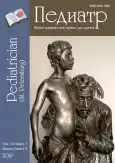Whole exome sequencing: principles and diagnostic capabilities
- Authors: Suspitsin E.N1, Tyurin V.I1, Imyanitov E.N1, Sokolenko A.P1
-
Affiliations:
- St Petersburg State Pediatric Medical University, Ministry of Healthcare of the Russian Federation
- Issue: Vol 7, No 4 (2016)
- Pages: 142-146
- Section: Articles
- URL: https://journals.eco-vector.com/pediatr/article/view/5980
- DOI: https://doi.org/10.17816/PED74142-146
- ID: 5980
Cite item
Abstract
Keywords
Full Text
About the authors
Evgeny N Suspitsin
St Petersburg State Pediatric Medical University, Ministry of Healthcare of the Russian Federation
Author for correspondence.
Email: evgeny.suspitsin@gmail.com
MD, PhD, Associate Professor, Department of Medical Genetics Russian Federation
Vladislav I Tyurin
St Petersburg State Pediatric Medical University, Ministry of Healthcare of the Russian Federation
Email: tyurinvladislav@gmail.com
Resident doctor, Department of Medical Genetics Russian Federation
Evgeny N Imyanitov
St Petersburg State Pediatric Medical University, Ministry of Healthcare of the Russian Federation
Email: evgeny@imyanitov.spb.ru
MD, PhD, Dr Med Sci, Professor, Head, Department of Medical Genetics Russian Federation
Anna P Sokolenko
St Petersburg State Pediatric Medical University, Ministry of Healthcare of the Russian Federation
Email: annasokolenko@mail.ru
MD, PhD, Associate Professor, Department of Medical Genetics Russian Federation
References
- Aldahmesh MA, Li Y, Alhashem A, et al. IFT27, encoding a small GTPase component of IFT particles, is mutated in a consanguineous family with Bardet-Biedl syndrome. Hum Mol Genet. 2014;23:3307-3315. doi: 10.1093/hmg/ddu044.
- Baker E, Jeste SS. Diagnosis and management of autism spectrum disorder in the era of genomics: rare disorders can pave the way for targeted treatments. Pediatr Clin North Am. 2015;62(3):607-618. doi: 10.1016/j.pcl.2015.03.003.
- Chinen J, Notarangelo LD, Shearer WT. Advances in basic and clinical immunology in 2014. J Allergy Clin Immunol. 2015;135(5):1132-41. doi: 10.1016/j.jaci.2015.02.037.
- de Bruin C, Dauber A. Insights from exome sequen¬cing for endocrine disorders. Nat Rev Endocrinol. 2015;11(8):455-64. doi: 10.1038/nrendo.2015.72.
- Francescatto L, Katsanis N. Newborn screening and the era of medical genomics. Semin Perinatol. 2015;39(8):617-22. doi: 10.1053/j.semperi.2015.
- 010.
- Gilissen C, Hoischen A, Brunner HG, Veltman JA. Unlocking Mendelian disease using exome sequencing. Genome Biol. 2011;12:228. doi: 10.1186/gb-2011-12-9-228.
- Ghaoui R, Cooper ST, Lek M, et al. Use of Whole-Exome Sequencing for Diagnosis of Limb-Girdle Muscular Dystrophy: Outcomes and Lessons Learned. JAMA Neurol. 2015;5:1-9. doi: 10.1001/jamaneurol.2015.2274.
- Green RC, Berg JS, Grody WW, et al. ACMG recommendations for reporting of incidental findings in clinical exome and genome sequencing. Genet Med. 2013;15(7):565-74. doi: 10.1038/gim.2013.73.
- Hoischen A, Krumm N, Eichler EE. Prioritization of neurodevelopmental disease genes by discovery of new mutations. Nat Neurosci. 2014;17(6):764-72. doi: 10.1038/nn.3703.
- Ku CS, Cooper DN, Polychronakos C, et al. Exome sequencing: dual role as a discovery and diagnostic tool. Ann Neurol. 2012;71:5-14. doi: 10.1002/ana.22647.
- Ng SB, Buckingham KJ, Lee C, et al. Exome sequencing identifies the cause of a mendelian disorder. Nat Genet. 2010;42:30-35. doi: 10.1038/ng.499.
- Platt C, Geha RS, Chou J. Gene hunting in the genomic era: approaches to diagnostic dilemmas in patients with primary immunodeficiencies. J Allergy Clin Immunol. 2014;134:262-8. doi: 10.1016/j.jaci.2013.08.021.
- Rabbani B, Tekin M, Mahdieh N. The promise of whole-exome sequencing in medical genetics. J Hum Genet. 2014;59:5-15. doi: 10.1038/jhg.2013.114.
- Shashi V, McConkie-Rosell A, Rosell B, et al. The utility of the traditional medical genetics diagnostic evaluation in the context of next-generation sequencing for undiagnosed genetic disorders. Genet Med. 2014;16(2):176-82. doi: 10.1038/gim.2013.99.
- Schreiber M, Dorschner M, Tsuang D. Next-generation sequencing in schizophrenia and other neuropsychiatric disorders. Am J Med Genet. Part B: Neuropsychiatr Genet. 2013;162(7):671-8. doi: 10.1002/ajmg.b.32156.
- Singleton AB. Exome sequencing: a transformative technology. Lancet Neurol. 2011;10:942-946. doi: 10.1016/S1474-4422(11)70196-X.
- Sokolenko AP, Suspitsin EN, Kuligina ESh, et al. Identification of novel hereditary cancer genes by whole exome sequencing. Cancer Lett. 2015;369(2):274-88. doi: 10.1016/j.canlet.2015.09.014.
- Suspitsin EN, Sokolenko AP, Lyazina LV, et al. Exome Sequencing of a Family with Bardet-Biedl Syndrome Identifies the Common Russian Mutation c.1967_1968delTAinsC in BBS7. Mol Syndromol. 2015;6(2):96-8. doi: 10.1159/000371408.
- Valencia CA, Husami A, Holle J, et al. Clinical Impact and Cost-Effectiveness of Whole Exome Sequencing as a Diagnostic Tool: A Pediatric Center’s Experience. Front Pediatr. 2015;(3):67. doi: 10.3389/fped.2015.00067.
Supplementary files








